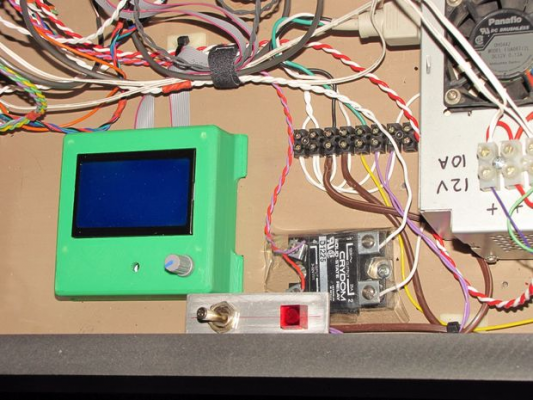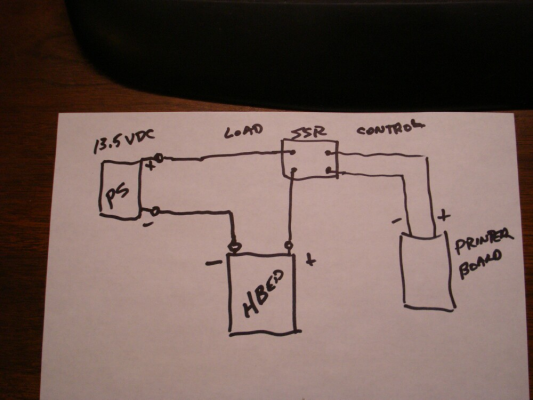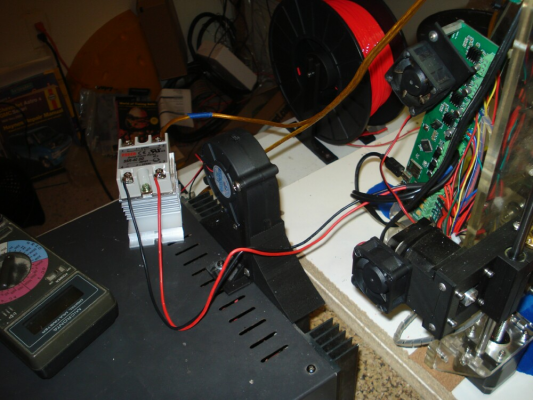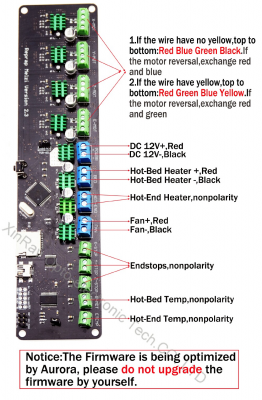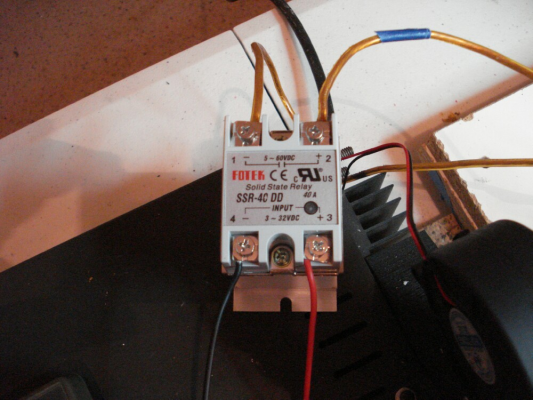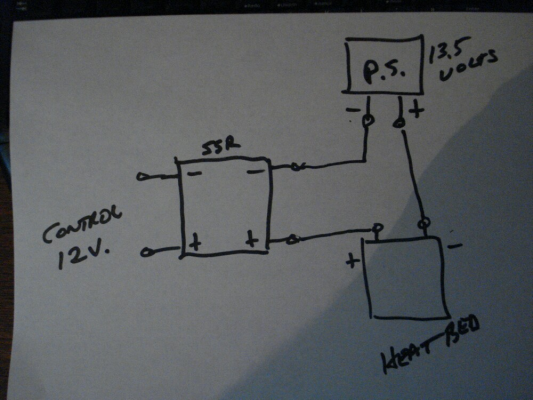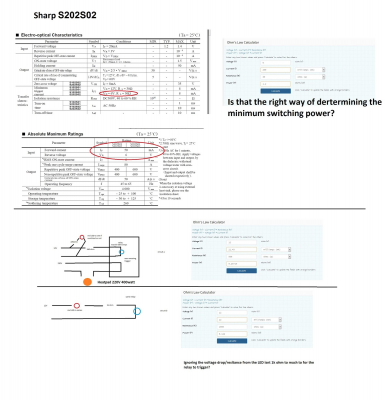Home
>
Reprappers
>
Topic
Anyone familiar with this?
Posted by elwood127
|
Anyone familiar with this? October 15, 2015 01:32AM |
Registered: 9 years ago Posts: 705 |
We discussed SS Relays for controlling heatbeds with a dedicated power supply. Was wondering if anyone has tried this less costly option? Thanks.
[www.ebay.com]
[www.ebay.com]
|
Re: Anyone familiar with this? October 15, 2015 06:33AM |
Registered: 11 years ago Posts: 5,780 |
Here's a DC-DC SSR good for 40A for $6: [www.ebay.com]. A DC SSR will get hot without a heatsink, and will drop the voltage to the heater a little, so you might have to turn up the power supply voltage, especially if you are using a marginally spec'd heater.
If you power the bed with AC instead of DC you can run an SSR without a heatsink. I switch power to my 450W bed heater using an DC-AC SSR under PID control and it doesn't even get warm operating without a heatsink.
I wouldn't print without PID temperature control of the bed heater- the print quality would be unacceptable, and I wouldn't use a mechanical relay under PID control- the noise it makes would drive me nutz.
A mechanical relay has limited cycle life. PID control would quickly kill it.
The mechanical relay you linked isn't cheap, it will be noisy, and it will have limited operating life in a 3D printer. What's good about it?
Edit: Here's a DC SSR with heatsink for $10: [www.ebay.com]
Edited 1 time(s). Last edit at 10/15/2015 06:37AM by the_digital_dentist.
Ultra MegaMax Dominator 3D printer: [drmrehorst.blogspot.com]
If you power the bed with AC instead of DC you can run an SSR without a heatsink. I switch power to my 450W bed heater using an DC-AC SSR under PID control and it doesn't even get warm operating without a heatsink.
I wouldn't print without PID temperature control of the bed heater- the print quality would be unacceptable, and I wouldn't use a mechanical relay under PID control- the noise it makes would drive me nutz.
A mechanical relay has limited cycle life. PID control would quickly kill it.
The mechanical relay you linked isn't cheap, it will be noisy, and it will have limited operating life in a 3D printer. What's good about it?
Edit: Here's a DC SSR with heatsink for $10: [www.ebay.com]
Edited 1 time(s). Last edit at 10/15/2015 06:37AM by the_digital_dentist.
Ultra MegaMax Dominator 3D printer: [drmrehorst.blogspot.com]
|
Re: Anyone familiar with this? October 15, 2015 12:24PM |
Registered: 10 years ago Posts: 14,672 |
Be very wary of cheap DC-DC SSRs on ebay. They generally have bipolar transistor output and in consequence a high voltage drop. The one that DD linked to in the previous post quotes a voltage drop of 1.6V. So if you use one to switch a 20A bed heater, that's around 30W of heat to get rid of. This calls for a fan as well as a heatsink.
You can get DC-DC SSRs with much lower voltage drops, but they use different technology and cost a lot more.
DC-AC SSRs are a different matter, because although the voltage drop is similar, the current they have to switch is much lower if you use AC mains voltage.
As for PID control or not, bang-bang control is entirely adequate on both my printers, giving a bed temperature fluctuation of about 0.2C. However, you can safely use slow PWM with both DC-DC and DC-AC SSRs.
Large delta printer [miscsolutions.wordpress.com], E3D tool changer, Robotdigg SCARA printer, Crane Quad and Ormerod
Disclosure: I design Duet electronics and work on RepRapFirmware, [duet3d.com].
You can get DC-DC SSRs with much lower voltage drops, but they use different technology and cost a lot more.
DC-AC SSRs are a different matter, because although the voltage drop is similar, the current they have to switch is much lower if you use AC mains voltage.
As for PID control or not, bang-bang control is entirely adequate on both my printers, giving a bed temperature fluctuation of about 0.2C. However, you can safely use slow PWM with both DC-DC and DC-AC SSRs.
Large delta printer [miscsolutions.wordpress.com], E3D tool changer, Robotdigg SCARA printer, Crane Quad and Ormerod
Disclosure: I design Duet electronics and work on RepRapFirmware, [duet3d.com].
|
Re: Anyone familiar with this? October 15, 2015 02:21PM |
Registered: 9 years ago Posts: 65 |
|
Re: Anyone familiar with this? October 15, 2015 03:07PM |
Registered: 10 years ago Posts: 14,672 |
When you say "switching frequency of the PID" I think you mean the PWM frequency used at the PID output. The default Arduino PWM frequencies of 400 to 800Hz are indeed to fast for a DC-AC SSR. However, slower PWM frequencies such as 1Hz work fine with these SSRs. So it all depends on the implementation.
Large delta printer [miscsolutions.wordpress.com], E3D tool changer, Robotdigg SCARA printer, Crane Quad and Ormerod
Disclosure: I design Duet electronics and work on RepRapFirmware, [duet3d.com].
Large delta printer [miscsolutions.wordpress.com], E3D tool changer, Robotdigg SCARA printer, Crane Quad and Ormerod
Disclosure: I design Duet electronics and work on RepRapFirmware, [duet3d.com].
|
Re: Anyone familiar with this? October 15, 2015 03:37PM |
Registered: 11 years ago Posts: 5,780 |
IRIC, Marlin uses a maximum PID frequency of 7 Hz. I used to use it unmodified to switch AC power into the 24V transformer that powers my bed heater. When I switched to a SmoothieBoard controller, the default PID frequency was 20Hz which I turned down to 8 Hz because it was blowing circuit breakers at 20 Hz, even though the SSR has a zero-crossing detector built in. PID works fine with AC SSRs that have zero-crossing detectors.
My machine has a Crydom D1225 SSR:
Ultra MegaMax Dominator 3D printer: [drmrehorst.blogspot.com]
My machine has a Crydom D1225 SSR:
Ultra MegaMax Dominator 3D printer: [drmrehorst.blogspot.com]
|
Re: Anyone familiar with this? October 15, 2015 06:16PM |
Registered: 9 years ago Posts: 705 |
|
Re: Anyone familiar with this? October 15, 2015 11:14PM |
Registered: 9 years ago Posts: 65 |
Thanks for the replies guys. Apparently I was WAY out, I thought I'd read typical PID was 8kHz.... must have been the beers! Didn't realize the AC SSRs would have zero crossing detection. Out of curiosity DD what hardware were you using in the first case to get the 7Hz PID frequency? A new build I'm planing is going to use Mega 2560+RAMPS (because I already have a couple on hand), that may change though as I hear there can be some issues in corexy designs. We'll see.
I'm curious why the 20hz was popping your breaker. I wonder if that setup some kind of resonance with the transformer you are using. Anyway I'll be using 120V all the way through.
Thanks again.
I'm curious why the 20hz was popping your breaker. I wonder if that setup some kind of resonance with the transformer you are using. Anyway I'll be using 120V all the way through.
Thanks again.
|
Re: Anyone familiar with this? October 16, 2015 07:11AM |
Registered: 11 years ago Posts: 5,780 |
Not all AC SSRs have zero cross detection, so select a part carefully.
I was originally running Marlin on a Arduino/RAMPS set up. I don't know which file has the PID frequency setting because it worked OK with the default and I never went looking to change it. Smoothieboard defaults to a 20Hz maximum PID frequency which can be changed (like everything else) in the config.txt file.
I am powering my 24V bed heater using a 0.5 kVA transformer and switching AC input to the transformer using the SSR. The 20 Hz default frequency in Smoothieware was causing the machine to blow circuit breakers in my house. I suspect that even with zero crossing detection, the transformer rings and maybe causes the zero crossing detector to screw up because of it. Whatever the actual problem is, turning down the maximum PID frequency to 8Hz solved it for me.
Edited 1 time(s). Last edit at 10/16/2015 07:12AM by the_digital_dentist.
Ultra MegaMax Dominator 3D printer: [drmrehorst.blogspot.com]
I was originally running Marlin on a Arduino/RAMPS set up. I don't know which file has the PID frequency setting because it worked OK with the default and I never went looking to change it. Smoothieboard defaults to a 20Hz maximum PID frequency which can be changed (like everything else) in the config.txt file.
I am powering my 24V bed heater using a 0.5 kVA transformer and switching AC input to the transformer using the SSR. The 20 Hz default frequency in Smoothieware was causing the machine to blow circuit breakers in my house. I suspect that even with zero crossing detection, the transformer rings and maybe causes the zero crossing detector to screw up because of it. Whatever the actual problem is, turning down the maximum PID frequency to 8Hz solved it for me.
Edited 1 time(s). Last edit at 10/16/2015 07:12AM by the_digital_dentist.
Ultra MegaMax Dominator 3D printer: [drmrehorst.blogspot.com]
|
Re: Anyone familiar with this? October 16, 2015 07:43PM |
Registered: 9 years ago Posts: 705 |
|
Re: Anyone familiar with this? October 16, 2015 08:07PM |
Registered: 11 years ago Posts: 5,780 |
Yes. If you switch AC power into a transformer it tends to have high inrush current, even with zero crossing detection in the SSR. If you try doing that too fast you can create a very high surge current that can trip a circuit breaker in your house.
If your bed heater is made to operate at 117VAC, it will be OK to run the PID at a high frequency because a resistive load won't produce the same inrush current that an inductive load like a transformer will.
Don't try to switch AC power into a switching power supply using PID control. The power supply will probably fail in short order.
Edited 1 time(s). Last edit at 10/16/2015 09:08PM by the_digital_dentist.
Ultra MegaMax Dominator 3D printer: [drmrehorst.blogspot.com]
If your bed heater is made to operate at 117VAC, it will be OK to run the PID at a high frequency because a resistive load won't produce the same inrush current that an inductive load like a transformer will.
Don't try to switch AC power into a switching power supply using PID control. The power supply will probably fail in short order.
Edited 1 time(s). Last edit at 10/16/2015 09:08PM by the_digital_dentist.
Ultra MegaMax Dominator 3D printer: [drmrehorst.blogspot.com]
|
Re: Anyone familiar with this? October 16, 2015 08:44PM |
Registered: 9 years ago Posts: 705 |
|
Re: Anyone familiar with this? October 21, 2015 01:25AM |
Registered: 9 years ago Posts: 65 |
Just to expand on what DD said... Transformers have an inrush current that lasts a few cycles, however, if power is suddenly cut the collapsing magnetic field in the core will create a voltage (in a sense act as a generator) for a very short period of time and try to feed it back to the source with an opposite polarity. So what I suspect is happening in DD's case is at the faster frequency the field isn't yet dissipated before the SSR switches and isn't dealing with just the inrush if the transformer but the back feed of that collapsing magnetic field as well causing a very short spike in current. Probably not destructive but enough to trip a standard house breaker which are typically pretty sensitive..
|
Re: Anyone familiar with this? October 21, 2015 01:45AM |
Registered: 9 years ago Posts: 705 |
|
Re: Anyone familiar with this? October 24, 2015 07:46PM |
Registered: 9 years ago Posts: 705 |
OK, bought a 40A 3-32V, 5-60V SSR like the one mentioned above. It sends power to the heatbed no matter the state of the switch. One of those "you get what you pay for" deals. Have ordered another from the US. Unless I'm an idiot I think this should have worked.
|
Re: Anyone familiar with this? October 24, 2015 08:24PM |
Registered: 11 years ago Posts: 5,780 |
What are the pins on the controller board?
Test it without the controller board- connect the control input pins to the power supply and see if it behaves as expected.
Edited 1 time(s). Last edit at 10/24/2015 08:25PM by the_digital_dentist.
Ultra MegaMax Dominator 3D printer: [drmrehorst.blogspot.com]
Test it without the controller board- connect the control input pins to the power supply and see if it behaves as expected.
Edited 1 time(s). Last edit at 10/24/2015 08:25PM by the_digital_dentist.
Ultra MegaMax Dominator 3D printer: [drmrehorst.blogspot.com]
|
Re: Anyone familiar with this? October 25, 2015 12:24AM |
Registered: 9 years ago Posts: 705 |
Melzi 2 board.
With no control wires hooked up to the ssr the power supply goes to the HB as soon as power is turned on. With the PS off and control power off there is no continuity at the load terminals. With control power on there is. Oddly, when all power is on there is no continuity on the load side yet power is flowing to HB. And, oddly enough, with all power off, touching continuity leads to load side produces a split second chirp. Do it again and nothing. Wait 30 seconds and load side will chirp again and so on. With HB control off, I'm seeing .015 volts at the ssr control inputs. Main board must be leaking voltage. Testing the ssr and it switches normally. Control power on, LED goes on and load side is conductive. Remove power and it switches off. Yet turning on load power with no control wires hooked up and heat bed heats up. Very confusing.
With no control wires hooked up to the ssr the power supply goes to the HB as soon as power is turned on. With the PS off and control power off there is no continuity at the load terminals. With control power on there is. Oddly, when all power is on there is no continuity on the load side yet power is flowing to HB. And, oddly enough, with all power off, touching continuity leads to load side produces a split second chirp. Do it again and nothing. Wait 30 seconds and load side will chirp again and so on. With HB control off, I'm seeing .015 volts at the ssr control inputs. Main board must be leaking voltage. Testing the ssr and it switches normally. Control power on, LED goes on and load side is conductive. Remove power and it switches off. Yet turning on load power with no control wires hooked up and heat bed heats up. Very confusing.
|
Re: Anyone familiar with this? October 25, 2015 03:51AM |
Registered: 10 years ago Posts: 14,672 |
Did you connect the + and - load terminals the right way round?
Large delta printer [miscsolutions.wordpress.com], E3D tool changer, Robotdigg SCARA printer, Crane Quad and Ormerod
Disclosure: I design Duet electronics and work on RepRapFirmware, [duet3d.com].
Large delta printer [miscsolutions.wordpress.com], E3D tool changer, Robotdigg SCARA printer, Crane Quad and Ormerod
Disclosure: I design Duet electronics and work on RepRapFirmware, [duet3d.com].
|
Re: Anyone familiar with this? October 25, 2015 08:31AM |
Registered: 11 years ago Posts: 5,780 |
It sounds like you have a bad SSR. If it's powering the bed heater with no control input it's not working properly. The input to the SSR is usually an opto isolator, and the control voltage input simply turns on an LED. If the LED has no current, it will produce no light and the SSR should remain off.
Ultra MegaMax Dominator 3D printer: [drmrehorst.blogspot.com]
Ultra MegaMax Dominator 3D printer: [drmrehorst.blogspot.com]
|
Re: Anyone familiar with this? October 25, 2015 10:44AM |
Registered: 9 years ago Posts: 705 |
Thanks DD. That's my conclusion as well. Hey DC, the load connection is a simple in and out deal. Not sure why they would add + and - marks on the SSR. The SSR load just breaks the positive lead to the heatbed with ground wired directly to the power supply. We'll see what happens in a couple of days when the new one arrives. thanks guys.
|
Re: Anyone familiar with this? October 25, 2015 10:46AM |
Registered: 10 years ago Posts: 14,672 |
When using a DC-DC SSR, the polarity of the output terminals does matter. If you get it wrong and the SSR uses a mosfet output, you will get exactly the behaviour you observe.
Edited 1 time(s). Last edit at 10/25/2015 10:46AM by dc42.
Large delta printer [miscsolutions.wordpress.com], E3D tool changer, Robotdigg SCARA printer, Crane Quad and Ormerod
Disclosure: I design Duet electronics and work on RepRapFirmware, [duet3d.com].
Edited 1 time(s). Last edit at 10/25/2015 10:46AM by dc42.
Large delta printer [miscsolutions.wordpress.com], E3D tool changer, Robotdigg SCARA printer, Crane Quad and Ormerod
Disclosure: I design Duet electronics and work on RepRapFirmware, [duet3d.com].
|
Re: Anyone familiar with this? October 25, 2015 03:33PM |
Registered: 9 years ago Posts: 705 |
|
Re: Anyone familiar with this? October 25, 2015 03:35PM |
Registered: 10 years ago Posts: 14,672 |
Quote
elwood127
The only way that would work is if the control voltage was being past ( through ) the SSR to load side terminals. That would defeat the whole purpose. A relay acts as a switch. breaking one leg of a two legged circuit.
Not true. You obviously don't understand how an SSR works. It is not like a mechanical relay. Think of an SSR with a mosfet output as a mechanical relay with a diode connected across the output contacts, and a diode in series with the input coil.
Edited 1 time(s). Last edit at 10/25/2015 03:39PM by dc42.
Large delta printer [miscsolutions.wordpress.com], E3D tool changer, Robotdigg SCARA printer, Crane Quad and Ormerod
Disclosure: I design Duet electronics and work on RepRapFirmware, [duet3d.com].
|
Re: Anyone familiar with this? October 25, 2015 04:05PM |
Registered: 9 years ago Posts: 705 |
|
Re: Anyone familiar with this? October 25, 2015 04:07PM |
Registered: 9 years ago Posts: 705 |
|
Re: Anyone familiar with this? October 25, 2015 04:33PM |
Registered: 10 years ago Posts: 14,672 |
Quote
elwood127
This is the only other way that it could be hooked up then.
[attachment 64680 DSC00654.jpg]
In that diagram, the SSR is connected the wrong way round. A correct way is:
- Connect the + output terminal of the SSR to the + output of the PSU;
- Connect the - output terminal of the SSR to one terminal of the bed heater (the + terminal, if the bed heater has + and - terminals);
- Connect the other terminal of the bed heater to the - terminal of the PSU.
Large delta printer [miscsolutions.wordpress.com], E3D tool changer, Robotdigg SCARA printer, Crane Quad and Ormerod
Disclosure: I design Duet electronics and work on RepRapFirmware, [duet3d.com].
|
Re: Anyone familiar with this? October 25, 2015 06:41PM |
Registered: 9 years ago Posts: 705 |
|
Re: Anyone familiar with this? October 26, 2015 05:14AM |
Registered: 9 years ago Posts: 445 |
Quote
elwood127
I appreciate your thoughts but that is exactly how my first diagram reads. Thanks again.
It is, but looking at your photo it looks like you have attached the cable going to your hotbed (the one with blue tape) to the positive side of the SSD, the side that ought to connected to the + terminal of the PSU.
|
Re: Anyone familiar with this? October 26, 2015 05:38AM |
Registered: 10 years ago Posts: 14,672 |
Quote
elwood127
I appreciate your thoughts but that is exactly how my first diagram reads. Thanks again.
OK, then it does sound as if the SSR is faulty. From your photo it appears to be a Fotek SSR-40DD. However, on the Fotek web site, the largest DC-DC SSR they list is the SSR-10DD. So I wonder whether it is a fake.
Cheap DC-DC SSRs use bipolar output transistors and have a voltage drop of typically 1.5 to 2V. This means they get very hot when passing large amounts of current, e.g. at 20A one of them would dissipate between 30W and 40W. This requires a very good heatsink, and probably a fan.
Another characteristic of DC-DC SSRs with bipolar output transistors is that if you subject them to more than a few volts of reverse polarity on the output side, you will fuse the base-emitter junction of the output transistor.
If you must use a DC-DC SSR, get one with a mosfet output and low voltage drop, for example a Crydom DC100D40. Sadly, these are not cheap. Alternative solutions include:
- Use an AC mains powered heated bed and a DC-AC SSR. The bed current is much less so the power dissipated in the SSR is much lower. Also you can use a smaller power supply because it doesn't supply the bed current. But you have to take more safety precautions such as protecting grounding, safeguarding the mains wiring, cable strain relief, and preferably RCD protection. It's easy to do on a delta printer, less so on a printer with a moving bed.
- Use a 24V bed heater instead of 12V. Then the bed current is halved and if that brings it down to around 10A, normal printer electronics can drive it directly.
- You can also buy or make a SevenSwitch, which is good to about 15A.
Large delta printer [miscsolutions.wordpress.com], E3D tool changer, Robotdigg SCARA printer, Crane Quad and Ormerod
Disclosure: I design Duet electronics and work on RepRapFirmware, [duet3d.com].
|
Re: Anyone familiar with this? October 26, 2015 10:58AM |
Registered: 11 years ago Posts: 805 |
I just came from my local electronics store after they sold me a broken relay and I got a 2nd opinion on the circuit.
Im using an small optical zero crossing relay that way i dont need a back emf diode but I need to regulate the switching current from the ramps down.
Circuit a) was what the first guy recommended me and given that I understood the minimum switching current correctly the 560ohm resistor makes sense.
but now that I talked to the shop owner he recommended (circuit b) the control LED in series and a 1k ohm resistor which seems a lot given that the led will drop the current even more.
So if you want to critique my circuits here ge ahead and given that I have the right minimum switching current which current would you recommend.
Im using an small optical zero crossing relay that way i dont need a back emf diode but I need to regulate the switching current from the ramps down.
Circuit a) was what the first guy recommended me and given that I understood the minimum switching current correctly the 560ohm resistor makes sense.
but now that I talked to the shop owner he recommended (circuit b) the control LED in series and a 1k ohm resistor which seems a lot given that the led will drop the current even more.
So if you want to critique my circuits here ge ahead and given that I have the right minimum switching current which current would you recommend.
Sorry, only registered users may post in this forum.
